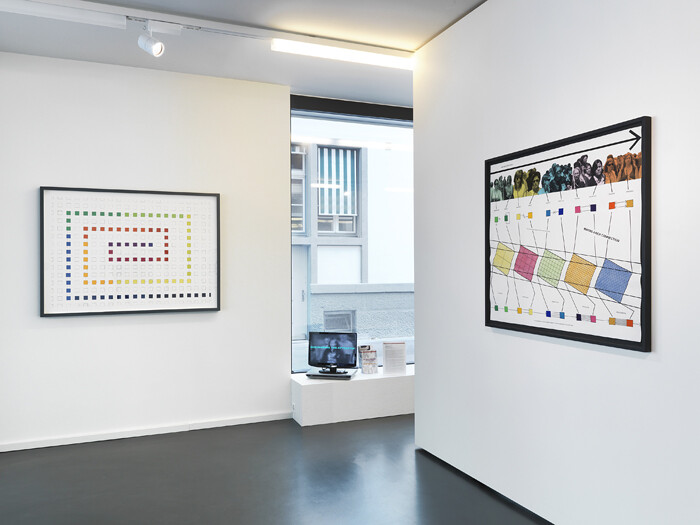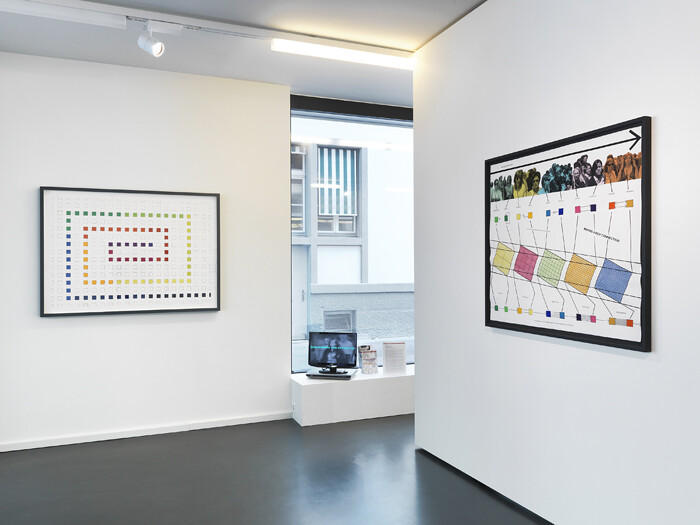It’s tempting to throw Londoner Stephen Willats in with the crop of neglected artists born in the first half of the last century currently being “unearthed” by the voracious contemporary market machine. Willats, born in 1943, may fit the generation, but to suggest that he required rediscovery would be misleading. Nonetheless, despite solo shows in the UK alone in the last two years at the South London Gallery, Raven Row, Modern Art Oxford, and Victoria Miro—a gallery with whom he has a longstanding collaboration—his work still feels anachronistic. The earliest piece in this exhibition of drawings at Anne Mosseri-Marlio Galerie is from 2008, yet Willats’ practice retains the positivism of the mid-1960s, when he first started working.
“Attracting the Attractor” is a cabinet-style presentation of 17 drawings and 2 digitized Super-8 films. The visitor first encounters Making a Rich Connection (2008), a drawing topped with a frieze of figures photographed in the street; lines pointing to some of these people identify them in various relationships from “stranger,” to “accomplice,” or “soulmate.” Below the frieze these identities are associated with squares that interact in different manners, as defined by the lines between and around them. These interactions and connections become progressively denser as the relationships indicated become more intimate. “As communication increases so a greater number of variables are available in the concept frame,” the legend along the base tells us. Willats’ working method is akin to an engineer’s, generating a design blueprint mapping out actions that can be adjusted and shared amongst users, demonstrating his logic-based thinking. Willats has used such drawings throughout his career to develop concepts about society, our living environments and everyday interactions. His drawings here appear on approximately A0 or A1 white paper, geometric forms in strong pencil line are colored in bright gouache or acrylic washes, and sometimes captions in Letraset text or collaged photographic elements are added. Throughout these diagrams, squares feature frequently as a unit form subjected to forces indicated by simple arrows that catalyze effects, effects sometimes specified and sometimes not, creating open schemes onto which the viewer can project their own possibilities.
There is tension between the import of the subject matter—social relations, people and their environments, for a start—and the spareness of Willats’ drawings. The artist applies “black box” systems whose internal workings are not evident, but which are known to have a given effect on what enters and exits them. This particular group of works and diagrams from the series “The Strange Attractor” (the pieces included in the exhibition are from 2008–14) is inspired by cyberneticist Heinz von Foerster’s mathematical use of the term, as a means of framing what is knowable in any given system. Willats applies the concept—his interpretation is “that ‘things’ are pulled toward something, but you can’t see and do not need to see the whole picture, but you can possess that part of the process which you witness,”—to life in our time, specifically how we relate to the other human subjects we encounter around us, and our presumptions about them.1
The filmmaker John Smith, more-or-less Willats’ contemporary and another Londoner, also made the activity of watching passers-by central in works, particularly in The Girl Chewing Gum (1976), in which Smith’s voiceover appears to direct the actions of figures filmed in the street, though they are, in fact, unaware of being observed. Smith and Willats thus both focussed their attention on an activity regarded as idle or inconsequential, but while the immediate result of Smith’s film is comedy, Willats seriously considers the complexity or simplicity of the multitude of perspectives coexisting at any given time. As much as I make assumptions about the person I encounter walking towards me on a pavement, he suggests, I am the object of their assumptions, too. Every interaction contains the potential of a profound—or more superficial—engagement, whether between people, or things. Willats’ two short films from 2014, presented on monitors, reduce this premise. In Attracting the Attractor, he picks out couples walking in the street and adds a layer of speculative commentary with overlaid captions such us “THE STRANGE ATTRACTOR” and “CHASING THE ATTRACTOR,” while in Still Life with Text pairs of vases are given similar treatment, this time with such descriptions as “HYPNOTISED” and “ENTRANCED.”
In the 1970s, Willats moved his practice out of the studio and into real life, looking—as he says in a 2008 film about his career—“for polemical issues to embody the works.”2 In the following decades he initiated and engaged with collaborative, community projects, frequently based around housing developments or tower blocks. One of the first, for example, was the “The West London Social Resource Project” (1972-3), which involved canvassing large numbers of participants about how they lived and their desired environments, and then displaying and publishing the results. Many more would follow.3 His unspectacular actions directly queried art’s role and usefulness in society—Willats possesses a fundamental faith that art does have a meaningful function to carry out. So if the language to be found in his drawings and films seems at times outmoded, its wordy formality and tones of science fiction hark back to an era of optimism, when ambitious claims and solemnity were declarations of intent and preludes to action. While the drawings undoubtedly have something to offer as purely formal objects, Willats’ texts always indicate the lacunae—the context the viewer has to contribute to make sense of these systems. An act that means abandoning our contemporary habit of relativism, which so often stymies any judgement, for an old fashioned affirmative relativism that embraces the complexity of life.
From the booklet “Attracting the Attractor” by Stephen Willats, published by Anne Mosseri-Marlio Galerie on the occasion of this exhibition.
A State of Agreement, 2008, UK. 34:00 minutes. Directed by Charlotte Ginsborg. Produced by Stephanie Willats. The film can be viewed at http://www.controlmagazine.org/stateofagreement.php.
Documentation from several of these projects was on show in the archive exhibition “Stephen Willats: Concerning Our Present Way of Living,” at the Whitechapel Gallery, London, until September 14, 2014.










